Promoting Positive Behaviour: Restrictive Interventions in Health Care
VerifiedAdded on 2023/03/22
|8
|2024
|38
Report
AI Summary
This report provides an overview of promoting positive behavior within health and social care settings. It begins by outlining key legislations related to restrictive interventions, such as the Health and Safety at Work Act and the Mental Capacity Act, and then details various interventions used to foster positive behavior, emphasizing the importance of least restrictive approaches. The report differentiates between proactive and reactive strategies, highlighting the significance of child-centered approaches in healthcare. It further classifies challenging behavior into self-injury, physical aggression, and verbal aggression, offering steps to maintain dignity and respect while managing such incidents. The conclusion emphasizes the need for professional handling of behavioral challenges and the utilization of new technologies to improve patient care and communication.
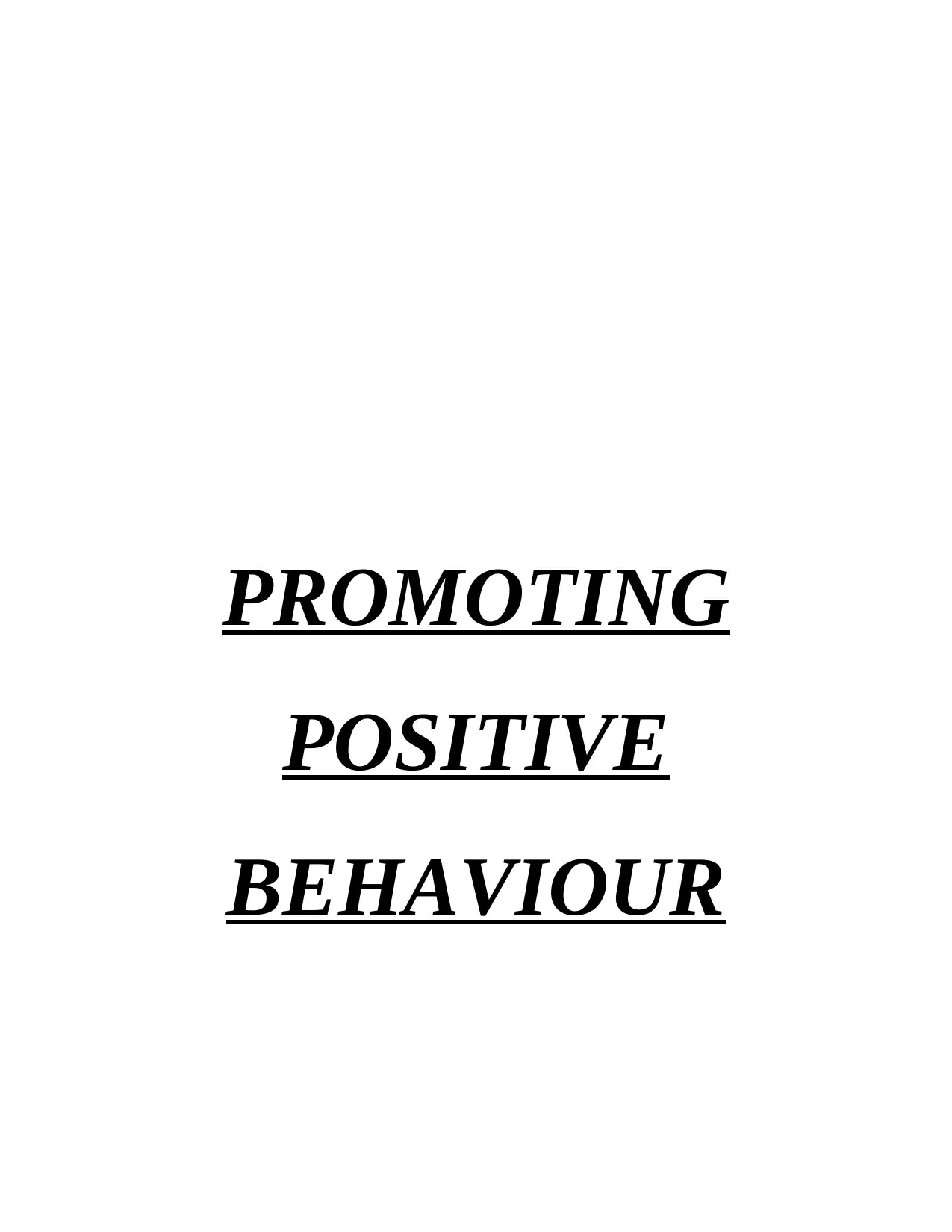
PROMOTING
POSITIVE
BEHAVIOUR
POSITIVE
BEHAVIOUR
Paraphrase This Document
Need a fresh take? Get an instant paraphrase of this document with our AI Paraphraser
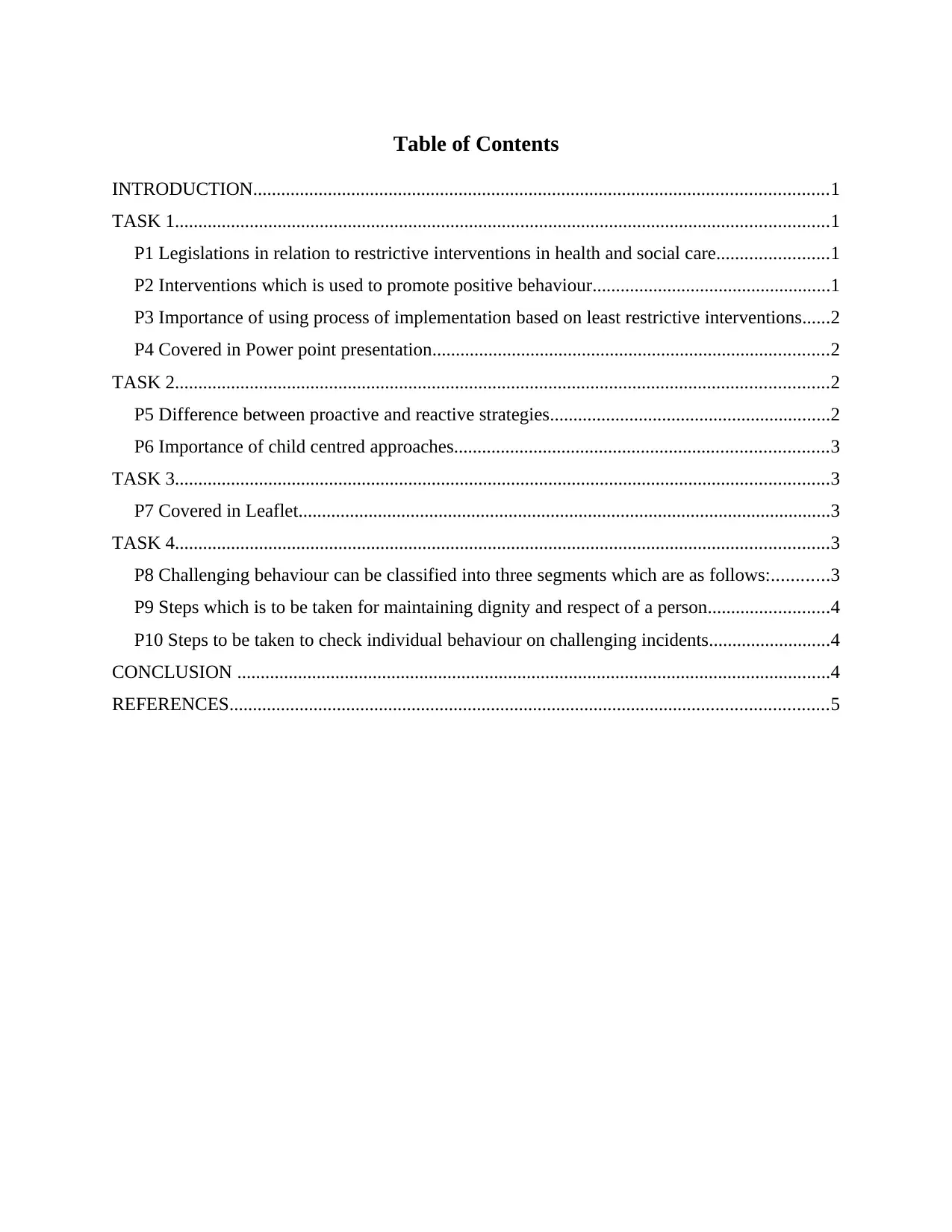
Table of Contents
INTRODUCTION...........................................................................................................................1
TASK 1............................................................................................................................................1
P1 Legislations in relation to restrictive interventions in health and social care........................1
P2 Interventions which is used to promote positive behaviour...................................................1
P3 Importance of using process of implementation based on least restrictive interventions......2
P4 Covered in Power point presentation.....................................................................................2
TASK 2............................................................................................................................................2
P5 Difference between proactive and reactive strategies............................................................2
P6 Importance of child centred approaches................................................................................3
TASK 3............................................................................................................................................3
P7 Covered in Leaflet..................................................................................................................3
TASK 4............................................................................................................................................3
P8 Challenging behaviour can be classified into three segments which are as follows:............3
P9 Steps which is to be taken for maintaining dignity and respect of a person..........................4
P10 Steps to be taken to check individual behaviour on challenging incidents..........................4
CONCLUSION ...............................................................................................................................4
REFERENCES................................................................................................................................5
INTRODUCTION...........................................................................................................................1
TASK 1............................................................................................................................................1
P1 Legislations in relation to restrictive interventions in health and social care........................1
P2 Interventions which is used to promote positive behaviour...................................................1
P3 Importance of using process of implementation based on least restrictive interventions......2
P4 Covered in Power point presentation.....................................................................................2
TASK 2............................................................................................................................................2
P5 Difference between proactive and reactive strategies............................................................2
P6 Importance of child centred approaches................................................................................3
TASK 3............................................................................................................................................3
P7 Covered in Leaflet..................................................................................................................3
TASK 4............................................................................................................................................3
P8 Challenging behaviour can be classified into three segments which are as follows:............3
P9 Steps which is to be taken for maintaining dignity and respect of a person..........................4
P10 Steps to be taken to check individual behaviour on challenging incidents..........................4
CONCLUSION ...............................................................................................................................4
REFERENCES................................................................................................................................5
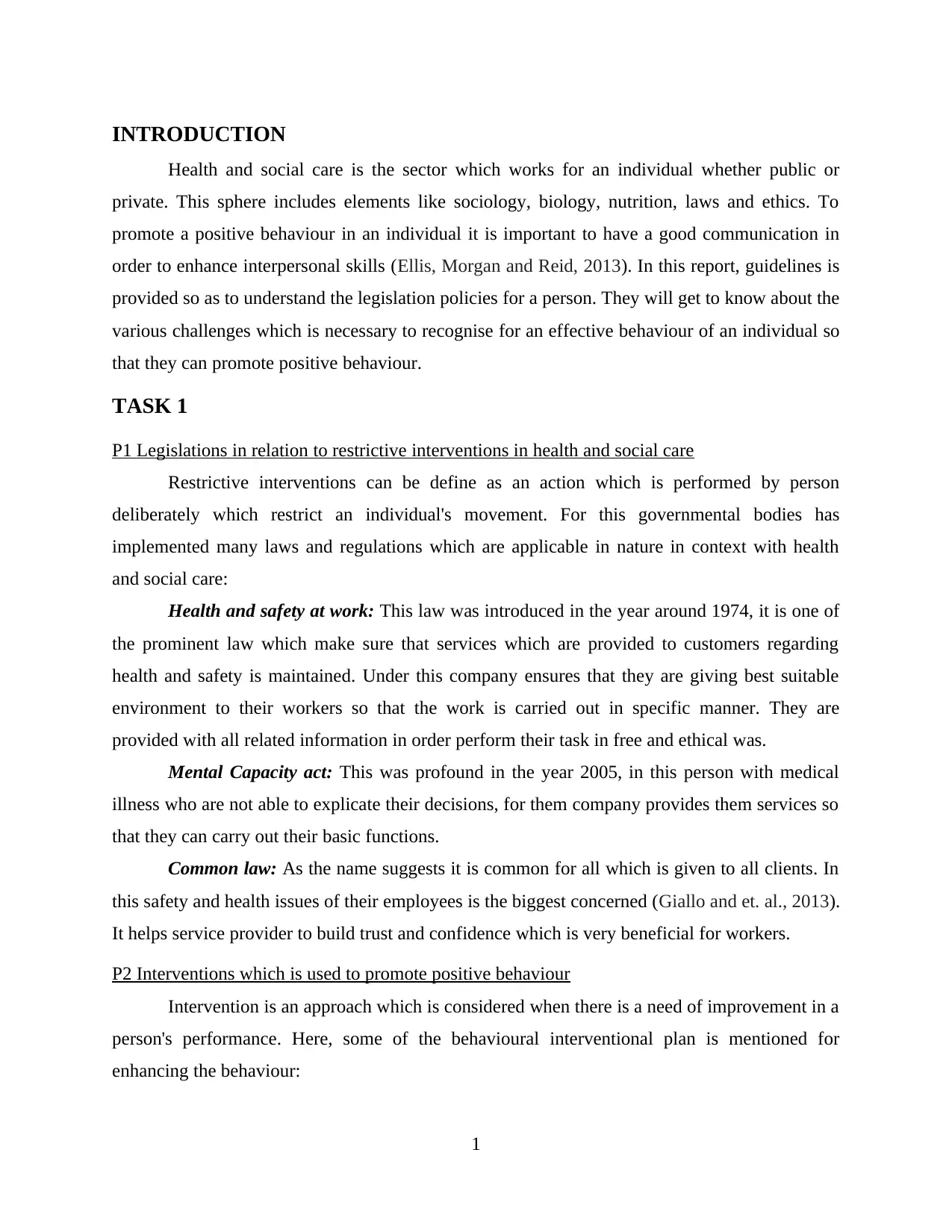
INTRODUCTION
Health and social care is the sector which works for an individual whether public or
private. This sphere includes elements like sociology, biology, nutrition, laws and ethics. To
promote a positive behaviour in an individual it is important to have a good communication in
order to enhance interpersonal skills (Ellis, Morgan and Reid, 2013). In this report, guidelines is
provided so as to understand the legislation policies for a person. They will get to know about the
various challenges which is necessary to recognise for an effective behaviour of an individual so
that they can promote positive behaviour.
TASK 1
P1 Legislations in relation to restrictive interventions in health and social care
Restrictive interventions can be define as an action which is performed by person
deliberately which restrict an individual's movement. For this governmental bodies has
implemented many laws and regulations which are applicable in nature in context with health
and social care:
Health and safety at work: This law was introduced in the year around 1974, it is one of
the prominent law which make sure that services which are provided to customers regarding
health and safety is maintained. Under this company ensures that they are giving best suitable
environment to their workers so that the work is carried out in specific manner. They are
provided with all related information in order perform their task in free and ethical was.
Mental Capacity act: This was profound in the year 2005, in this person with medical
illness who are not able to explicate their decisions, for them company provides them services so
that they can carry out their basic functions.
Common law: As the name suggests it is common for all which is given to all clients. In
this safety and health issues of their employees is the biggest concerned (Giallo and et. al., 2013).
It helps service provider to build trust and confidence which is very beneficial for workers.
P2 Interventions which is used to promote positive behaviour
Intervention is an approach which is considered when there is a need of improvement in a
person's performance. Here, some of the behavioural interventional plan is mentioned for
enhancing the behaviour:
1
Health and social care is the sector which works for an individual whether public or
private. This sphere includes elements like sociology, biology, nutrition, laws and ethics. To
promote a positive behaviour in an individual it is important to have a good communication in
order to enhance interpersonal skills (Ellis, Morgan and Reid, 2013). In this report, guidelines is
provided so as to understand the legislation policies for a person. They will get to know about the
various challenges which is necessary to recognise for an effective behaviour of an individual so
that they can promote positive behaviour.
TASK 1
P1 Legislations in relation to restrictive interventions in health and social care
Restrictive interventions can be define as an action which is performed by person
deliberately which restrict an individual's movement. For this governmental bodies has
implemented many laws and regulations which are applicable in nature in context with health
and social care:
Health and safety at work: This law was introduced in the year around 1974, it is one of
the prominent law which make sure that services which are provided to customers regarding
health and safety is maintained. Under this company ensures that they are giving best suitable
environment to their workers so that the work is carried out in specific manner. They are
provided with all related information in order perform their task in free and ethical was.
Mental Capacity act: This was profound in the year 2005, in this person with medical
illness who are not able to explicate their decisions, for them company provides them services so
that they can carry out their basic functions.
Common law: As the name suggests it is common for all which is given to all clients. In
this safety and health issues of their employees is the biggest concerned (Giallo and et. al., 2013).
It helps service provider to build trust and confidence which is very beneficial for workers.
P2 Interventions which is used to promote positive behaviour
Intervention is an approach which is considered when there is a need of improvement in a
person's performance. Here, some of the behavioural interventional plan is mentioned for
enhancing the behaviour:
1
⊘ This is a preview!⊘
Do you want full access?
Subscribe today to unlock all pages.

Trusted by 1+ million students worldwide
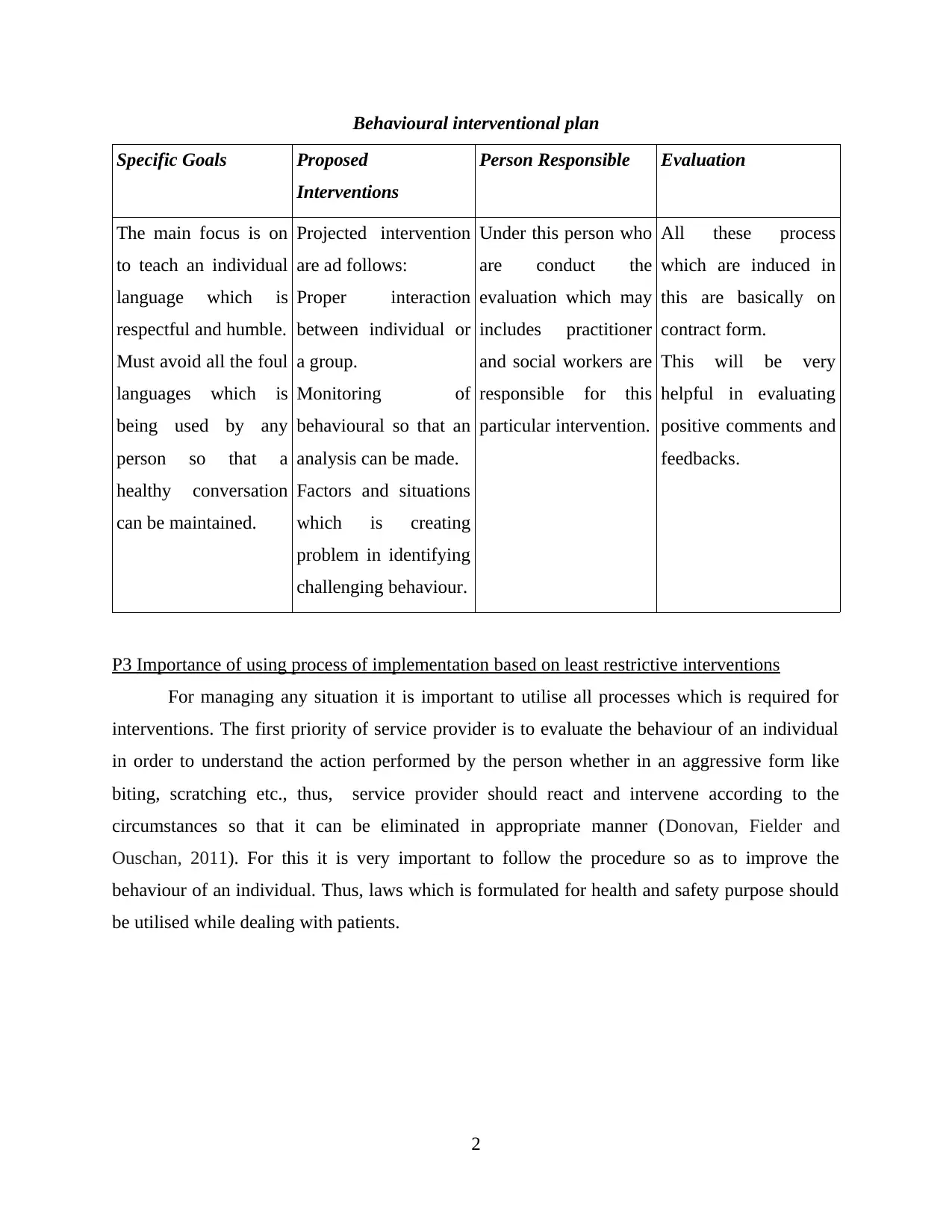
Behavioural interventional plan
Specific Goals Proposed
Interventions
Person Responsible Evaluation
The main focus is on
to teach an individual
language which is
respectful and humble.
Must avoid all the foul
languages which is
being used by any
person so that a
healthy conversation
can be maintained.
Projected intervention
are ad follows:
Proper interaction
between individual or
a group.
Monitoring of
behavioural so that an
analysis can be made.
Factors and situations
which is creating
problem in identifying
challenging behaviour.
Under this person who
are conduct the
evaluation which may
includes practitioner
and social workers are
responsible for this
particular intervention.
All these process
which are induced in
this are basically on
contract form.
This will be very
helpful in evaluating
positive comments and
feedbacks.
P3 Importance of using process of implementation based on least restrictive interventions
For managing any situation it is important to utilise all processes which is required for
interventions. The first priority of service provider is to evaluate the behaviour of an individual
in order to understand the action performed by the person whether in an aggressive form like
biting, scratching etc., thus, service provider should react and intervene according to the
circumstances so that it can be eliminated in appropriate manner (Donovan, Fielder and
Ouschan, 2011). For this it is very important to follow the procedure so as to improve the
behaviour of an individual. Thus, laws which is formulated for health and safety purpose should
be utilised while dealing with patients.
2
Specific Goals Proposed
Interventions
Person Responsible Evaluation
The main focus is on
to teach an individual
language which is
respectful and humble.
Must avoid all the foul
languages which is
being used by any
person so that a
healthy conversation
can be maintained.
Projected intervention
are ad follows:
Proper interaction
between individual or
a group.
Monitoring of
behavioural so that an
analysis can be made.
Factors and situations
which is creating
problem in identifying
challenging behaviour.
Under this person who
are conduct the
evaluation which may
includes practitioner
and social workers are
responsible for this
particular intervention.
All these process
which are induced in
this are basically on
contract form.
This will be very
helpful in evaluating
positive comments and
feedbacks.
P3 Importance of using process of implementation based on least restrictive interventions
For managing any situation it is important to utilise all processes which is required for
interventions. The first priority of service provider is to evaluate the behaviour of an individual
in order to understand the action performed by the person whether in an aggressive form like
biting, scratching etc., thus, service provider should react and intervene according to the
circumstances so that it can be eliminated in appropriate manner (Donovan, Fielder and
Ouschan, 2011). For this it is very important to follow the procedure so as to improve the
behaviour of an individual. Thus, laws which is formulated for health and safety purpose should
be utilised while dealing with patients.
2
Paraphrase This Document
Need a fresh take? Get an instant paraphrase of this document with our AI Paraphraser
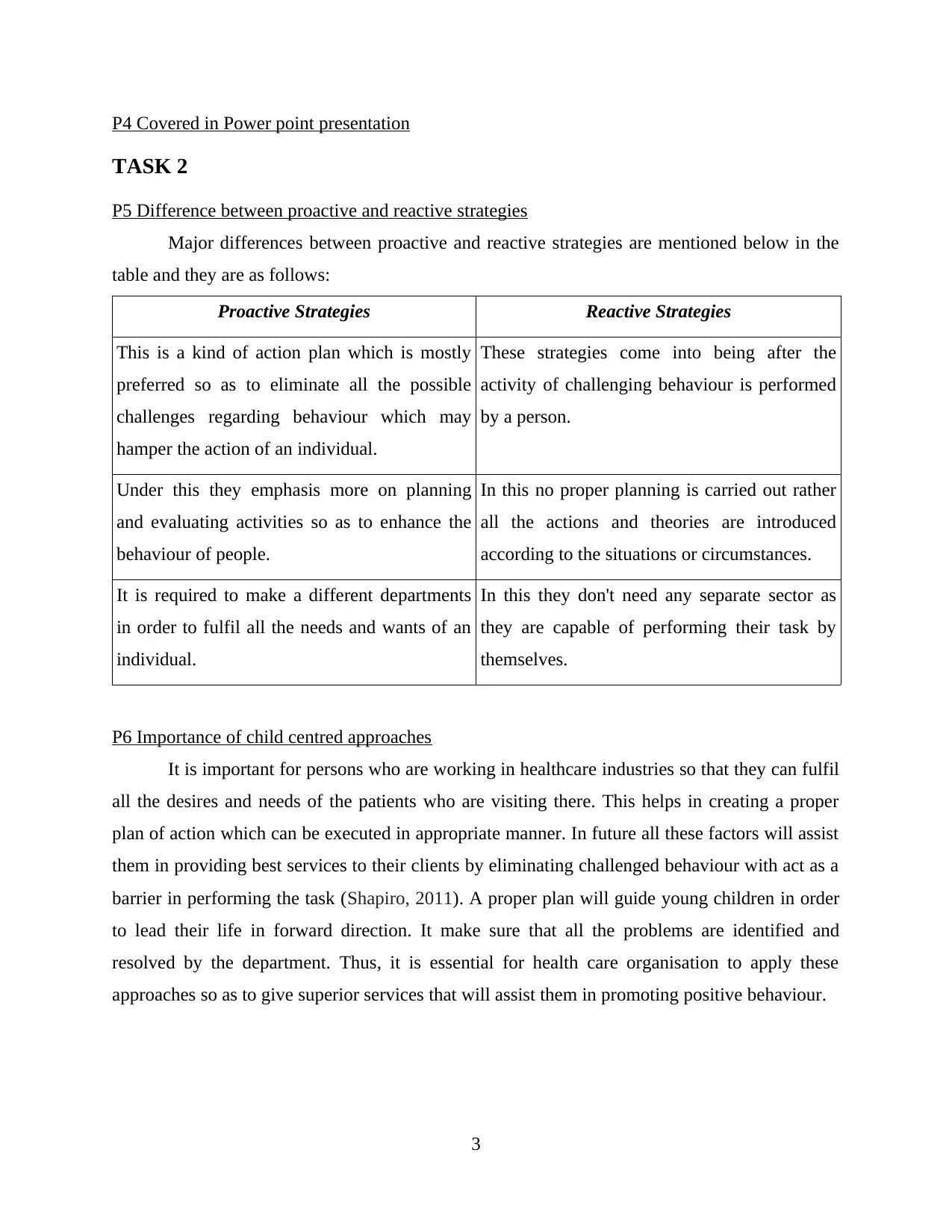
P4 Covered in Power point presentation
TASK 2
P5 Difference between proactive and reactive strategies
Major differences between proactive and reactive strategies are mentioned below in the
table and they are as follows:
Proactive Strategies Reactive Strategies
This is a kind of action plan which is mostly
preferred so as to eliminate all the possible
challenges regarding behaviour which may
hamper the action of an individual.
These strategies come into being after the
activity of challenging behaviour is performed
by a person.
Under this they emphasis more on planning
and evaluating activities so as to enhance the
behaviour of people.
In this no proper planning is carried out rather
all the actions and theories are introduced
according to the situations or circumstances.
It is required to make a different departments
in order to fulfil all the needs and wants of an
individual.
In this they don't need any separate sector as
they are capable of performing their task by
themselves.
P6 Importance of child centred approaches
It is important for persons who are working in healthcare industries so that they can fulfil
all the desires and needs of the patients who are visiting there. This helps in creating a proper
plan of action which can be executed in appropriate manner. In future all these factors will assist
them in providing best services to their clients by eliminating challenged behaviour with act as a
barrier in performing the task (Shapiro, 2011). A proper plan will guide young children in order
to lead their life in forward direction. It make sure that all the problems are identified and
resolved by the department. Thus, it is essential for health care organisation to apply these
approaches so as to give superior services that will assist them in promoting positive behaviour.
3
TASK 2
P5 Difference between proactive and reactive strategies
Major differences between proactive and reactive strategies are mentioned below in the
table and they are as follows:
Proactive Strategies Reactive Strategies
This is a kind of action plan which is mostly
preferred so as to eliminate all the possible
challenges regarding behaviour which may
hamper the action of an individual.
These strategies come into being after the
activity of challenging behaviour is performed
by a person.
Under this they emphasis more on planning
and evaluating activities so as to enhance the
behaviour of people.
In this no proper planning is carried out rather
all the actions and theories are introduced
according to the situations or circumstances.
It is required to make a different departments
in order to fulfil all the needs and wants of an
individual.
In this they don't need any separate sector as
they are capable of performing their task by
themselves.
P6 Importance of child centred approaches
It is important for persons who are working in healthcare industries so that they can fulfil
all the desires and needs of the patients who are visiting there. This helps in creating a proper
plan of action which can be executed in appropriate manner. In future all these factors will assist
them in providing best services to their clients by eliminating challenged behaviour with act as a
barrier in performing the task (Shapiro, 2011). A proper plan will guide young children in order
to lead their life in forward direction. It make sure that all the problems are identified and
resolved by the department. Thus, it is essential for health care organisation to apply these
approaches so as to give superior services that will assist them in promoting positive behaviour.
3
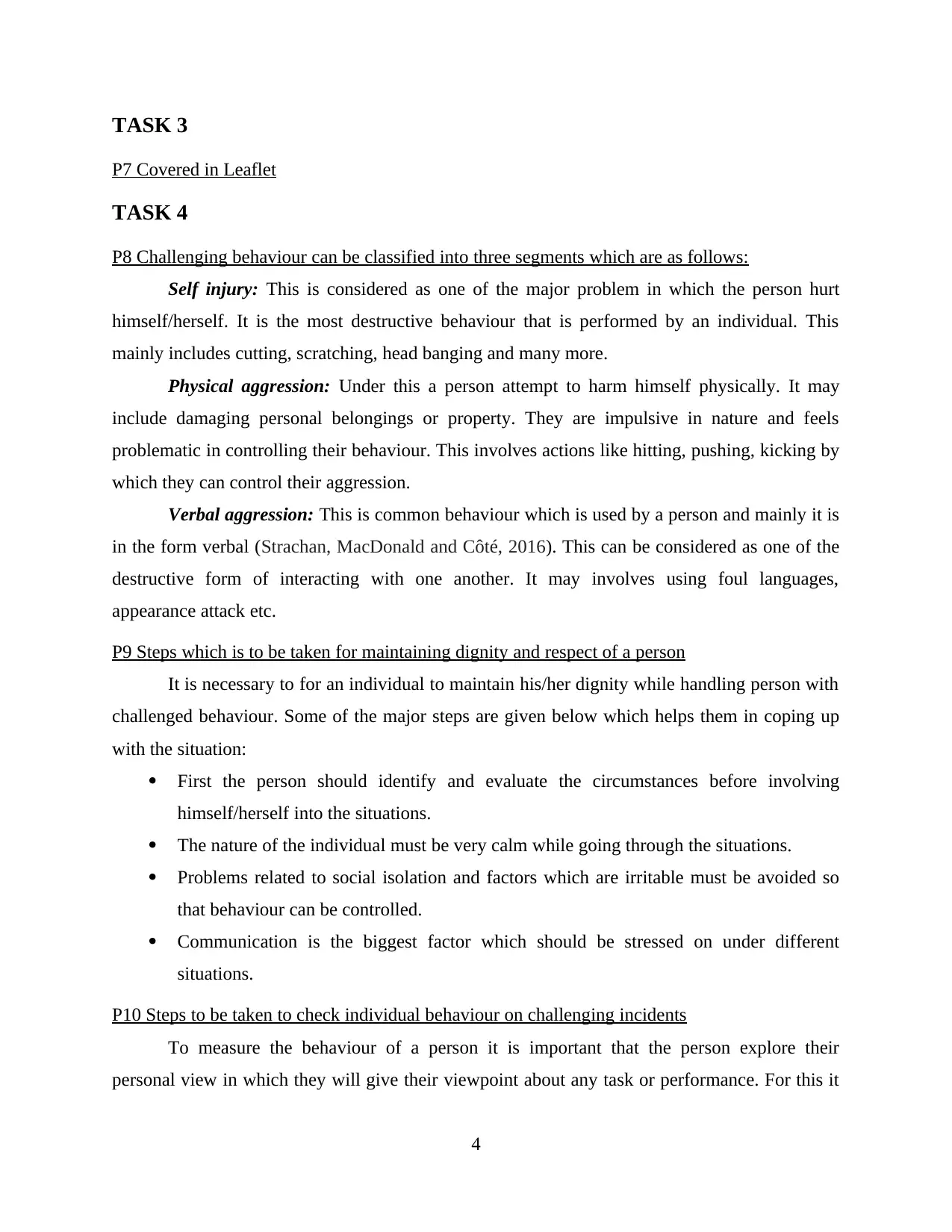
TASK 3
P7 Covered in Leaflet
TASK 4
P8 Challenging behaviour can be classified into three segments which are as follows:
Self injury: This is considered as one of the major problem in which the person hurt
himself/herself. It is the most destructive behaviour that is performed by an individual. This
mainly includes cutting, scratching, head banging and many more.
Physical aggression: Under this a person attempt to harm himself physically. It may
include damaging personal belongings or property. They are impulsive in nature and feels
problematic in controlling their behaviour. This involves actions like hitting, pushing, kicking by
which they can control their aggression.
Verbal aggression: This is common behaviour which is used by a person and mainly it is
in the form verbal (Strachan, MacDonald and Côté, 2016). This can be considered as one of the
destructive form of interacting with one another. It may involves using foul languages,
appearance attack etc.
P9 Steps which is to be taken for maintaining dignity and respect of a person
It is necessary to for an individual to maintain his/her dignity while handling person with
challenged behaviour. Some of the major steps are given below which helps them in coping up
with the situation:
First the person should identify and evaluate the circumstances before involving
himself/herself into the situations.
The nature of the individual must be very calm while going through the situations.
Problems related to social isolation and factors which are irritable must be avoided so
that behaviour can be controlled.
Communication is the biggest factor which should be stressed on under different
situations.
P10 Steps to be taken to check individual behaviour on challenging incidents
To measure the behaviour of a person it is important that the person explore their
personal view in which they will give their viewpoint about any task or performance. For this it
4
P7 Covered in Leaflet
TASK 4
P8 Challenging behaviour can be classified into three segments which are as follows:
Self injury: This is considered as one of the major problem in which the person hurt
himself/herself. It is the most destructive behaviour that is performed by an individual. This
mainly includes cutting, scratching, head banging and many more.
Physical aggression: Under this a person attempt to harm himself physically. It may
include damaging personal belongings or property. They are impulsive in nature and feels
problematic in controlling their behaviour. This involves actions like hitting, pushing, kicking by
which they can control their aggression.
Verbal aggression: This is common behaviour which is used by a person and mainly it is
in the form verbal (Strachan, MacDonald and Côté, 2016). This can be considered as one of the
destructive form of interacting with one another. It may involves using foul languages,
appearance attack etc.
P9 Steps which is to be taken for maintaining dignity and respect of a person
It is necessary to for an individual to maintain his/her dignity while handling person with
challenged behaviour. Some of the major steps are given below which helps them in coping up
with the situation:
First the person should identify and evaluate the circumstances before involving
himself/herself into the situations.
The nature of the individual must be very calm while going through the situations.
Problems related to social isolation and factors which are irritable must be avoided so
that behaviour can be controlled.
Communication is the biggest factor which should be stressed on under different
situations.
P10 Steps to be taken to check individual behaviour on challenging incidents
To measure the behaviour of a person it is important that the person explore their
personal view in which they will give their viewpoint about any task or performance. For this it
4
⊘ This is a preview!⊘
Do you want full access?
Subscribe today to unlock all pages.

Trusted by 1+ million students worldwide
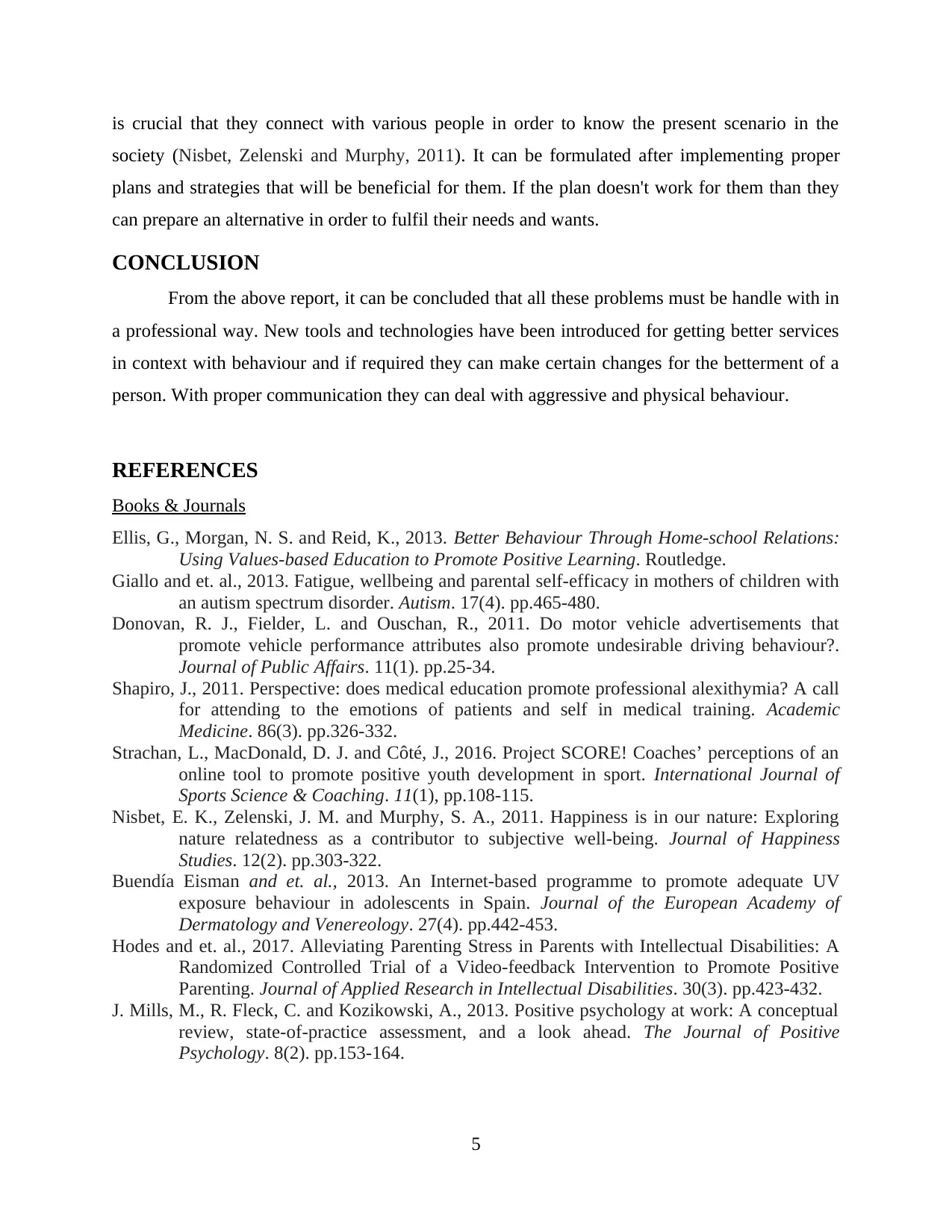
is crucial that they connect with various people in order to know the present scenario in the
society (Nisbet, Zelenski and Murphy, 2011). It can be formulated after implementing proper
plans and strategies that will be beneficial for them. If the plan doesn't work for them than they
can prepare an alternative in order to fulfil their needs and wants.
CONCLUSION
From the above report, it can be concluded that all these problems must be handle with in
a professional way. New tools and technologies have been introduced for getting better services
in context with behaviour and if required they can make certain changes for the betterment of a
person. With proper communication they can deal with aggressive and physical behaviour.
REFERENCES
Books & Journals
Ellis, G., Morgan, N. S. and Reid, K., 2013. Better Behaviour Through Home-school Relations:
Using Values-based Education to Promote Positive Learning. Routledge.
Giallo and et. al., 2013. Fatigue, wellbeing and parental self-efficacy in mothers of children with
an autism spectrum disorder. Autism. 17(4). pp.465-480.
Donovan, R. J., Fielder, L. and Ouschan, R., 2011. Do motor vehicle advertisements that
promote vehicle performance attributes also promote undesirable driving behaviour?.
Journal of Public Affairs. 11(1). pp.25-34.
Shapiro, J., 2011. Perspective: does medical education promote professional alexithymia? A call
for attending to the emotions of patients and self in medical training. Academic
Medicine. 86(3). pp.326-332.
Strachan, L., MacDonald, D. J. and Côté, J., 2016. Project SCORE! Coaches’ perceptions of an
online tool to promote positive youth development in sport. International Journal of
Sports Science & Coaching. 11(1), pp.108-115.
Nisbet, E. K., Zelenski, J. M. and Murphy, S. A., 2011. Happiness is in our nature: Exploring
nature relatedness as a contributor to subjective well-being. Journal of Happiness
Studies. 12(2). pp.303-322.
Buendía Eisman and et. al., 2013. An Internet‐based programme to promote adequate UV
exposure behaviour in adolescents in Spain. Journal of the European Academy of
Dermatology and Venereology. 27(4). pp.442-453.
Hodes and et. al., 2017. Alleviating Parenting Stress in Parents with Intellectual Disabilities: A
Randomized Controlled Trial of a Video‐feedback Intervention to Promote Positive
Parenting. Journal of Applied Research in Intellectual Disabilities. 30(3). pp.423-432.
J. Mills, M., R. Fleck, C. and Kozikowski, A., 2013. Positive psychology at work: A conceptual
review, state-of-practice assessment, and a look ahead. The Journal of Positive
Psychology. 8(2). pp.153-164.
5
society (Nisbet, Zelenski and Murphy, 2011). It can be formulated after implementing proper
plans and strategies that will be beneficial for them. If the plan doesn't work for them than they
can prepare an alternative in order to fulfil their needs and wants.
CONCLUSION
From the above report, it can be concluded that all these problems must be handle with in
a professional way. New tools and technologies have been introduced for getting better services
in context with behaviour and if required they can make certain changes for the betterment of a
person. With proper communication they can deal with aggressive and physical behaviour.
REFERENCES
Books & Journals
Ellis, G., Morgan, N. S. and Reid, K., 2013. Better Behaviour Through Home-school Relations:
Using Values-based Education to Promote Positive Learning. Routledge.
Giallo and et. al., 2013. Fatigue, wellbeing and parental self-efficacy in mothers of children with
an autism spectrum disorder. Autism. 17(4). pp.465-480.
Donovan, R. J., Fielder, L. and Ouschan, R., 2011. Do motor vehicle advertisements that
promote vehicle performance attributes also promote undesirable driving behaviour?.
Journal of Public Affairs. 11(1). pp.25-34.
Shapiro, J., 2011. Perspective: does medical education promote professional alexithymia? A call
for attending to the emotions of patients and self in medical training. Academic
Medicine. 86(3). pp.326-332.
Strachan, L., MacDonald, D. J. and Côté, J., 2016. Project SCORE! Coaches’ perceptions of an
online tool to promote positive youth development in sport. International Journal of
Sports Science & Coaching. 11(1), pp.108-115.
Nisbet, E. K., Zelenski, J. M. and Murphy, S. A., 2011. Happiness is in our nature: Exploring
nature relatedness as a contributor to subjective well-being. Journal of Happiness
Studies. 12(2). pp.303-322.
Buendía Eisman and et. al., 2013. An Internet‐based programme to promote adequate UV
exposure behaviour in adolescents in Spain. Journal of the European Academy of
Dermatology and Venereology. 27(4). pp.442-453.
Hodes and et. al., 2017. Alleviating Parenting Stress in Parents with Intellectual Disabilities: A
Randomized Controlled Trial of a Video‐feedback Intervention to Promote Positive
Parenting. Journal of Applied Research in Intellectual Disabilities. 30(3). pp.423-432.
J. Mills, M., R. Fleck, C. and Kozikowski, A., 2013. Positive psychology at work: A conceptual
review, state-of-practice assessment, and a look ahead. The Journal of Positive
Psychology. 8(2). pp.153-164.
5
Paraphrase This Document
Need a fresh take? Get an instant paraphrase of this document with our AI Paraphraser

Stack and et. al., 2014. General practitioners’ perspectives on campaigns to promote rapid help-
seeking behaviour at the onset of rheumatoid arthritis. Scandinavian journal of primary
health care. 32(1). pp.37-43.
6
seeking behaviour at the onset of rheumatoid arthritis. Scandinavian journal of primary
health care. 32(1). pp.37-43.
6
1 out of 8
Related Documents
Your All-in-One AI-Powered Toolkit for Academic Success.
+13062052269
info@desklib.com
Available 24*7 on WhatsApp / Email
![[object Object]](/_next/static/media/star-bottom.7253800d.svg)
Unlock your academic potential
Copyright © 2020–2025 A2Z Services. All Rights Reserved. Developed and managed by ZUCOL.





